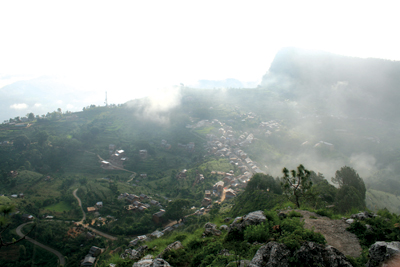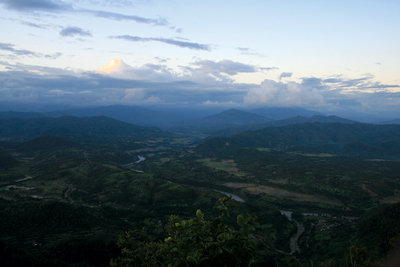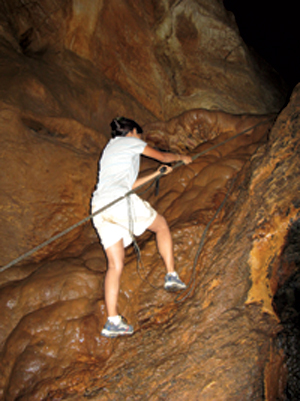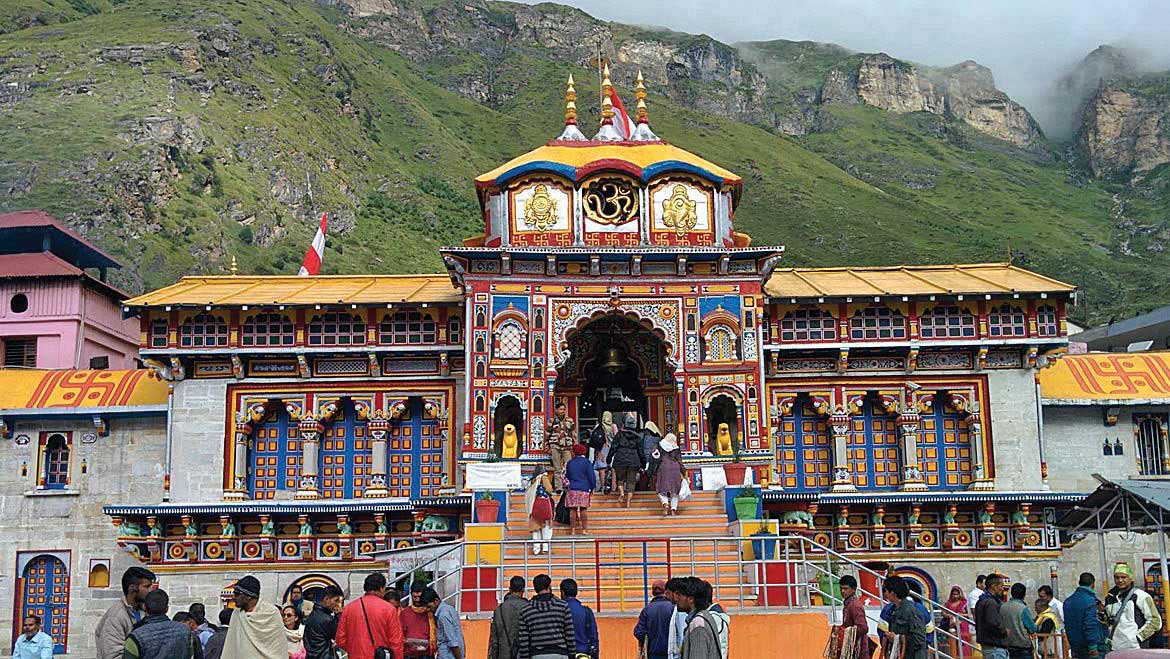Bandipur, once a popular stop on a busy trade route, is now a tourist destination, attracting both kinds of tourism – domestic and international.
Over the last two decades I’ve made umpteen trips to Pokhara for business or pleasure, with friends, family, or on my own. It never once crossed my mind, however, to visit Bandipur, a small town in the hills barely eight kilometers uphill from Dumre, a highway town on the way to Pokhara. Call it my good fortune that this year I finally made it to this ancient town. Once in Bandipur, I kept wondering how on earth I had missed the place for so long.
 Hill town
Hill town
One of the closest travel destinations, only 143 km or a four-hour drive west of Kathmandu, Bandipur is easily accessible from the wide and smooth Prithivi Highway. There are many buses en route to Pokhara, and each makes a routine stop at Dumre. From this bustling bazaar, you can catch a local bus or jeep uphill to Bandipur for 20 rupees. (Pokhara is another 72 km west of Dumre on the main road.) If you are driving, the narrow but paved eight km approach road that winds uphill calls for real driving skills, and the many twists and tricky turns reminded me of the Jiri highway in east Nepal. The scariest part for me and my family were the speeding locally operated jeeps and buses that literally bulged with travelers (in, on, and hanging off).They made us jump as they whizzed past without sounding horns, barely missing our vehicle on some of the more treacherous corners. We wound around the flank of a hill stacked with terraced fields, houses in little huddles and a beautiful stretch of sal saplings that lined the road. In half an hour we arrived at Bandipur. At the fringe of town we were flagged down by an attendant who informed us that the town center was not open to vehicles. So we parked and walked. As we entered the town we were astounded, for it was quite unlike the mundane picture of a hill town that we had painted in our minds.
Reliving Bhaktapur
At the entrance, a big legend board displayed the map of the town with names of all the prominent sites. Also for the taking was an exhaustive brochure about Bandipur. (It’s readily available in the many restaurants and the tourist information counter in the main square.) It saved us the trouble of finding a guide. A narrow alley laid with square cut flagstones led between brick houses on both sides to the main town square. The place was spotlessly clean — no filth, no garbage piles, not even the tiniest of plastic wrappers. As we strolled along soaking in the sights, what caught my eye were the shuttered windows and balconies on most houses. These blended in with the red brick façades reminiscent of rare neo-classical architecture of the distant past. A strong sense of déjà vu gripped me as we approached the main square. I realized in a flash that I felt as if transported to the ancient town of Bhaktapur, east of Kathmandu. By contrast, however, Bandipur appeared fresh and refurbished, much cleaner and with fewer people.
The laid-back ambience and solitude, redolent of an alley in Bhaktapur with the residents gone to attend to their fields, evoked a sense of tranquility and wellbeing so rare in cities. A number of lodges and restaurants had sit-out arrangements with colorful chairs and tables in front, bringing me back to the present. A few men and women were going about their work and small kids in fair numbers greeted us with broad smiles and curious eyes. Many were playing and chasing each other around the vehicle-free main square. We also came across tourists in small groups being conducted around by tour guides. In the main square, an old building called Durbar Ghar serves as the tourist information center. It is said to be the oldest house in town (130 years), and sits next to a shrine. At the far end of the bazaar stands a pagoda-style temple called Bindyabasini, highly revered by the Bandipur townsfolk. Thereafter the alley turns into a lane that leads to other must-visit spots like Raniban, Tundikhel (the parade ground), Khadgadevi Temple, Mahalaxmi Temple and the historic stone spouts called Teen Dhara. Next to those spouts stands a temple that houses the effigy of Lord Mahadev. It is believed to have been erected in the 13th century. It seemed to us that every lane and alley in the town had a temple or a shrine — so like the Newar towns of Bhaktapur, Patan and Kathmandu. Indeed, the Newars of Bandipur are descended from original immigrants from Bhaktapur.
Other notable sites include the silk farm. It is located by following a trail dotted with wild orchids to the outskirts of town. Also held in high esteem, the Notre Dame School, built by two Japanese missionaries, is located at the edge of the town. Renowned for slate mining, Bandipur literally sits on a slate quarry. Little surprise then, that the houses all have slate roofs and the alleys and lanes are paved in slate. For those who fancy hiking, the town is linked by a number of beaten trails like the ancient trail that runs from Dumre to Bandipur, the Ramkot trail and the trail to Siddha caves.

Tudikhel, atop Bandipur is a popular viewing point.
Spectacular views
The brochure informed us that situated at an elevation of 1030 meters, Bandipur straddles one of the crests of the Mahabharat chain of hills that roll across the mid-western mountainous terrain of Tanahun District, Gandaki Zone. The town sprawls along a narrow strip of land from the west towards the east, drops dramatically on two sides into terraced fields, clusters of slate-roofed houses and wooded hillsides. Thanimai hill also called Puranokot (the ridge previously held a kot, or fort) is a half hour climb west of the town. A bird’s eye view from there will make you wonder at how the entire main bazaar hugs the narrow hill top as the houses line up in a tight bunch. The north of the town opens onto a spectacular view as the Marsiangdi river meanders through a deep valley that rises to an array of soaring snow capped peaks. If you happen to be in Bandipur on a clear day, the northern skyline offers an unimpeded view of peaks like Dhaulagiri, Manaslu, Annapurna, Lamjung, and Ganesh. Also visible are the Gorkha Durbar (fort) and the Mankamana ridge (a famous pilgrimage site) from some vantage points. Unfortunately, on the day of our visit an impenetrable haze dashed our hopes of seeing the unspoiled vista.
Rich history and culture
After finding our way through most of the attractions around town, it was time for me to delve a bit into the history of Bandipur and its ancient civilization. The geographical location, the intricately carved temples, the unique architecture, the dominance of age-old temples and shrines and the diverse ethnicity, all evoked almost palpable to the senses a mute testimony to its rich culture and heritage. So, I popped into a shop at the town center and introduced myself to a gentleman who was happy to answer my questions. The more I dug into the past, the more fascinating historical facts about Bandipur surfaced.
“Bandipur is basically a Newar town”, said Raj Kumar Shrestha, the 56 year old shop-owner, a Newar resident from Bhaktapur who is considered one of the oldest residents of Bandipur. Here in a nutshell, is a history that came out of my tete-a-tete with Mr. Shrestha.
Originally, Bandipur (or for that matter the entire Kali Gandaki region and the mid western hills) was inhabited by the Magars, an ethnic group that established small kingdoms and ruled as great warriors. With the degradation and fall of the Magars, the Sen Dynasty ascended to power. King Mukunda Sen of Palpa, the most ambitious of all, divided his empire into Baishe Rajyas (22 principalities) among his heirs. Bandipur was ruled by Bhriggu Sen and his descendants until the 17th century. The rule of the Sen Dynasty fell after Prithvi Narayan Shah’s historic triumph over the many principalities and states scattered throughout Nepal.
The Newars, mostly from Bhaktapur, arrived at these far off hills, drawn by the prospects of trade and prosperity. An ancient trade route existed here as early as the 9th century. It spanned the mid western hills between the Terai plains as far as India in the south, and its reach in the north met the highlands of Tibet. It was in relation to this trade that Bandipur rose to bustling prominence, given the keen business acumen of those migrant Newars. Traders from Tibet peddled musk, animal skins, horses, and rare herbs, while merchandise like calico, tobacco, sugar, glassware and kerosene flowed in from British India. The post Second World War period also saw Bandipur develop flourishing textile industries, with a market that extended far and wide in the mid-western region. An obscure little town was thus turned into a commercial hub to which traders and villagers from Pokhara, Palpa, Gorkha, Tanahun and nearby provinces poured in. With the Newars came their deep-rooted ancestral culture, traditions, architecture and religious heritage. Today the ancient relics remain; the timeless architectural façades preserved, the Newar culture and religious practices retained and nurtured against the changing times.

Siddha Gufa is reportedly one of Nepal’s largest caves
The Newars
The first Newar migrants to Bandipur are believed to have arrived after the seizure of the three empires of the Nepal Valley, namely Kathmandu, Patan and Bhaktapur, by Prithivi Narayan Shah (of Gorkha) in 1768 AD. The Newar migrants, mostly from Bhaktapur, are believed to have settled in the Bandipur hills for reasons that were very rational. First, the town already had a worn trade route for them to capitalize on. And the weather, much the same as their native ground, was free from the dreaded malaria that infested the Terai plains below them.
That was how the Newars established their dominance in Bandipur. Families of Piyas, Shresthas, Pradhans, Sulpes and Rajbhandaris are the Newars of Bandipur. Lakhi Jatra, Khadga Jatra and Bisket Jatra celebrated in Bhaktapur have also found their way into the Newar traditions of Bandipur. Even the streets and alleys in the little town are named in Newari and the Newari dialect is still spoken by the older generation. Magars, though less in number in the town area, are concentrated in a nearby village called Ramkot, a two hour hike from Bandipur bazaar. The typical round shaped crude brick and thatched roof huts of the Magars in Ramkot claim to be the last vestiges of the old Magar prominence from the medieval era. Magar traditions, however, are kept alive in Bandipur by age-old Magar ghatu, sorathi and chutka dances. Brahmin, Chettri, Damai, Kami and Sarki castes form the minority. Ethnic Gurungs in some numbers also moved to Bandipur in later years.
Ghost town
Dark foreboding clouds were cast over Bandipur’s heyday by a strange twist of fate. Malaria, which had blighted the lives of those in the Terai plains, was suppressed in the 1960’s. Gradually, people began to move there, lured by the fertile farming land. What began as a trickle of migrants grew to a mass exodus with the construction of the Kathmandu-Pokhara highway, which bypassed the town entirely. This ultimately proved to be Bandipur’s undoing. Isolated and for quite some time inaccessible by a vehicular road, the once booming trade took a nose dive. The final straw was when Bandipur lost its status as district headquarters to Damauli situated 15 km away on the Pokhara highway. Many lives were lost and unpleasant skirmishes with the administration ensued as the people of Bandipur rose in rebellion; but all to no avail. For every Bandipure (inhabitant of Bandipur) it was a traumatic experience. Bandipur literally turned into a ghost town as the bulk of the Newar business community moved down the mountain to nearby highway towns, and to the Terai plains of Chitwan. Most of the Newars from the main bazaar area, however, did not sell off their houses. Rather, they retained them as the last vestiges of their rich heritage. Today these houses serve mostly as lodges and boarding houses.
Salvation
Time heals all wounds, as they say, and the Bandipures set out against all odds to redeem their situation by turning Bandipur into a model town. It was a mammoth task. An access road was built, old houses were given a facelift, temples and shrines were renovated and a massive drive was organized to keep the town clean. Funds were raised locally and some foreign aid was also channeled in. It was the sheer determination and dogged perseverance of the local people, however, that accounted for Bandipur’s revival. Their concerted effort, above all, saved the historical town from turning into ruins. Today, things have started to look up as the town is attracting both domestic and international tourists.
Bowels of the earth
After a very warm and revealing chat with Rajkumar, our plan was to visit Siddha Gufa, Nepal’s biggest cave. The midday sun, the sight-seeing walk around town and the thought of a two hour trail, however, dampened our enthusiasm. Since our tour of Bandipur was intended to last only a few hours, we started our drive back to Kathmandu. As it turned out, however, our visit to the cave seemed fated. Near Bimalnagar (back on the Pokhara to Kathmandu road), we were stopped by a blockade put up by a local crowd over a tragedy that had occurred at the nearby Marsiangdi hydroelectric dam. Two children playing by the dam were swept away by the sudden opening of the sluice gates; as a result, the aggrieved party took to the roads. Instead of wasting time waiting behind a long line of vehicles for the bandh to lift, we decided to drive back a few kilometers to take the trail to the famous cave.
A stiff, 45 minute climb in the afternoon sun proved sweaty and exhausting. We were, however, well rewarded for our efforts. I have never fancied crawling on all fours into the bowels of the earth, simply because of an unexplained dread called claustrophobia. The roof of the Siddha Caves, to my great relief, stood something like five times my height, so no crawling was required. The hurricane lamp cast eerie shadows against the inky darkness. Strange, bulbous stalactites hanging from the roof and stalagmites jutting out of the cave floor were a thrilling sight. The tour, almost an hour long, led close to half a kilometer deep into the recesses of the cave. Some places required careful negotiation down steel ladders or climbing up slippery slopes with the help of a rope. My wife and daughter were thrilled. Sadly, the cave walls were marked with graffiti. Far worse, many of the stalactite tips were broken off, obviously stolen. Nonetheless, it was a worthwhile experience.
Our family tour to Bandipur turned out to be more than just a daytrip to a quaint little town. It was also a journey through time into the rich history and culture of an ancient settlement that has survived the ravages of time intact. Our only regret was the shortness of the trip. We’ll make up for that on our next visit.









